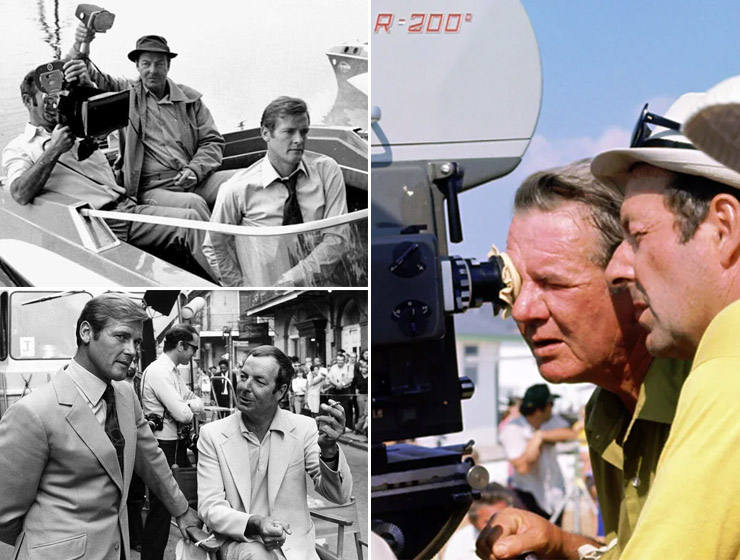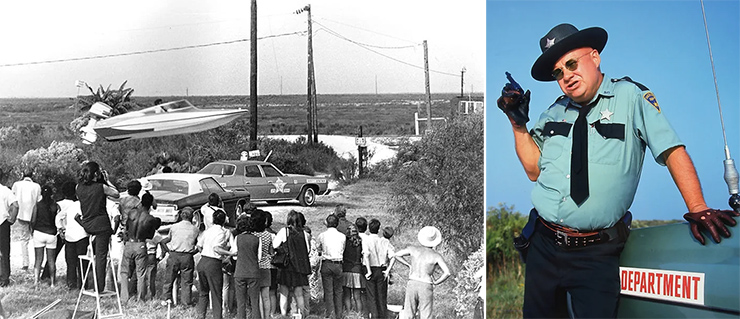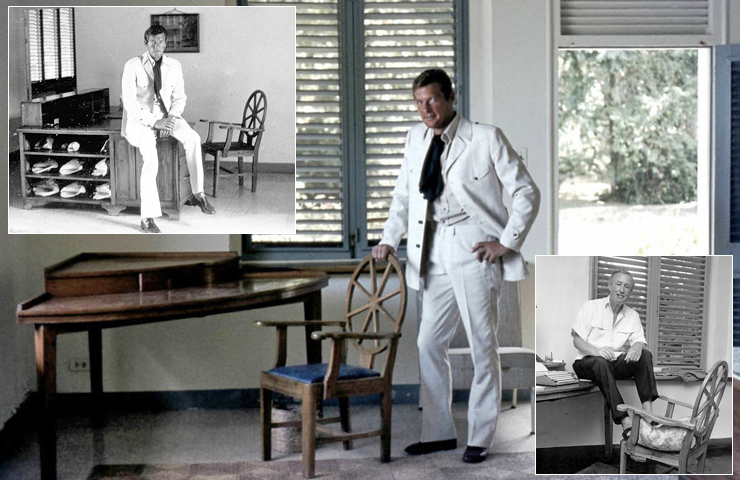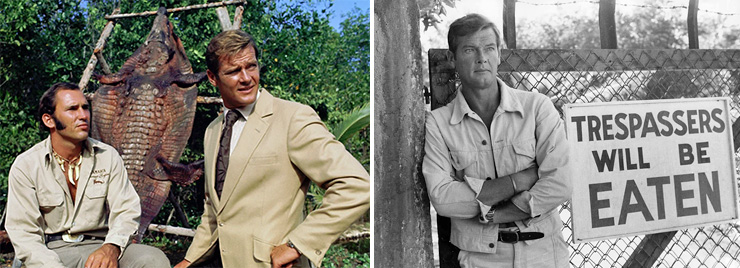 |
|
Prior to Moore’s casting,
director Guy Hamilton, screenwriter Tom Mankiewicz (who delivered his
first draft screenplay on May 5, 1972) and production designer Syd Cain
had been scouting locations in New Orleans and Jamaica (which stood in for
the fictional island of San Monique) where they discovered Ross Kananga’s
crocodile farm with its humourous sign announcing that “Trespassers will
be eaten”. The sign, farm and owner’s surname all made it into the final
film – with Kananga now appropriated as the name for the alter-ego of main
villain Mr. Big (played by Yaphet Kotto). British actress Jane Seymour was
cast as Solitaire after the producers had seen her in the popular BBC-TV
series The Onedin Line, which also featured
Michael Billington, who
had first tested for the role of James Bond in 1968. Billington would
later play KGB agent Sergei Barzov, who is killed by Roger Moore’s 007 in
the famous pre-title ski chase in The Spy Who Loved Me (1977). |
|
|
|
Tom Mankiewicz delivered
his final shooting script in October 1972, which now included a finale set
in Mr. Big’s underground grotto on a set designed by
Syd Cain and built at
Pinewood Studios – instead of the original ending from Ian Fleming’s novel
where Bond and Solitaire are keelhauled behind Mr. Big’s yacht The
Secatur, before he is killed by barracuda and sharks. The keelhauling
sequence would later be included in For Your Eyes Only (1981) by
On Her Majesty’s Secret Service (1969) screenwriter
Richard Maibaum.
Live And Let Die (1973) was the second film in the series to have
its script solely authored by one man (although there were numerous other
non-credited contributions to both films). Mankiewicz had rewritten
Maibaum’s Diamonds Are Forever script and can therefore be seen
(along with director Guy Hamilton) as being responsible for the
development of the more humourous tone of the James Bond films, which then
carried on throughout Roger Moore’s tenure in the role. |
 |
|
ABOVE: (top left)
Assisting the camera operator, four-time James Bond director Guy Hamilton
with Roger Moore on location in Louisiana filming the
Live And Let Die boat chase. (bottom left) Guy Hamilton
chats with Roger Moore on location in New Orleans, and (right)
lines up a shot with seven-time James Bond film cinematographer
Ted Moore.
BELOW: (left) Stuntman Jerry Comeaux performs the 110-foot
record-breaking jump over two cars and back into the bayou in the
spectacular Live And Let Die boat chase. (right) American
character actor Clifton James as redneck Sheriff J.W.
Pepper. |
|
 |
|
|
Live And Let Die
began its location filming in Louisiana on October 9, 1972 with rehearsals
for the spectacular boat chase. Principal photography began on October
13th with Roger Moore doing a lot of the driving of the speedboats
himself, adding to the realism of the scenes filmed without the aid of any
rear-projection, unlike earlier action sequences in the series. Two days
later stuntman Jerry Comeaux performed the impressive boat jump over two
cars and back into the bayou in two takes, watched by a large crowd, including veteran American character actor Clifton James, who
had been signed to play redneck Sheriff J.W. Pepper – a role he would
reprise in The Man With The Golden Gun (1974). The speedboat jump
made the Guinness Book of World Records for its distance of 110
feet, a record that stood for three years. At the end of October,
production moved to New Orleans to film the first of two jazz funerals
seen in Live And Let Die – followed by a week on location at
Lakefront Airport from November 1st, filming the car and airplane chase.
It was director Guy Hamilton’s idea to have a chase at an airport where
nobody ever took off! |
 |
|
ABOVE: Whilst
filming Live And Let Die in Jamaica, Roger Moore visited Ian
Fleming's home ‘Goldeneye’, and posed with Ian Fleming's
distinctive spoke-backed chair. [inset right] Author Ian Fleming
at ‘Goldeneye’ where he wrote the James Bond novels from 1952 to
1964.
BELOW: Roger Moore poses with crocodile/alligator farm owner Ross
Kananga (1945-1978), and at the farm’s main gate. |
|
 |
|
|
Location filming then
moved to Jamaica where Roger Moore took time out to have publicity
photographs taken at Ian Fleming’s home ‘Goldeneye’. It had been a decade
since the crew first visited the island to shoot Dr. No (1962), and
several locations appear in both films. The sequence where CIA double
agent Rosie Carver (Gloria Hendry) is killed was filmed in the garden of
the Ruins Restaurant at Ocho Rios. The Sans Souci Hotel, which stood in as
the exterior of Miss Taro’s bungalow on the fictitious Magenta Drive in
the first James Bond film, would also be used as the backdrop for Baron
Samedi’s (Geoffrey Holder) nightclub floorshow performance in Live And
Let Die. Bond’s escape from the crocodile farm was filmed at Ross
Kananga’s (1945-1978) Swamp Safari, his 350-acres of mangrove swamp on
Jamaica's North coast, where he kept over 1,000 crocodiles and alligators. Kananga himself suggested that Bond escape from the small island after
being stranded there by Tee Hee (played by Julius W. Harris) by jumping
across the backs of crocodiles. Kananga was then enlisted by the producers
to perform the stunt that required five takes to complete, including one
in which the last crocodile snapped at Kananga's heel, tearing his
trousers, and causing him a number of injuries – one of which required 193
stitches. Kananga was paid $60,000 for his contribution, and at Roger
Moore’s suggestion performed the jump wearing crocodile shoes! |
|
CONTINUED |
|
